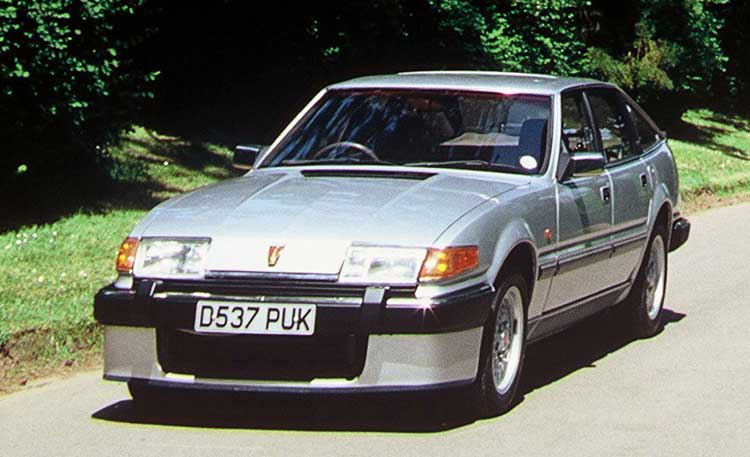Rover SD1
It was Car of the Year in 1976, but then bits of it started falling off. Lance Cole fondly recalls our best-designed, worst-made exec-mobile

Thirty years ago, Rover (or, rather, British Leyland) produced one of the best British cars ever designed. Sadly, this car was also one of the worst British cars ever made - made in the sense of thrown together with all the aplomb that BL, its inept management, and a defeatist workforce could manage.
The Rover 3500 - or the SD1, as it was better known - was an icon of industrial design and a car with immense character. It was a product of BL's Specialist Division (hence SD1) of Rover-Triumph. For the want of something known as "build quality", this car could have become the definitive 1970s and early 1980s executive car. Instead, BMW grabbed the glittering prizes (and, in the end, Rover itself).
The SD1 was fast and very safe (it passed the now fashionable offset crash test in 1975). It handled well, and, of course, it had the venerable ex-Buick light-weight alloy 155bhp V8 that had found its way into Rover's P5 and P6 battle-class cruisers from the 1960s onwards.
Above all, the SD1 had style. Faced with an aborted Rover P8, and a Giovanni Michelotti- penned half-Rover, half-Triumph 1970s half-baked saloon proposal, Rover let the designer David Bache loose. Bache turned in a car that ranked under Robert Hughes's "the shock of the new". A curvy behemoth, yet one that was also lithe and elegant, and sold in a range of brave colours - SD1s could be had in mustard, puce, slime and abattoir hues. A colour called Triton green really spiced up the super-car looks, though - Rover's design team drove Triton-green SD1s.
Legend has it that the Ferrari 375 Daytona inspired Bache - and overtones of it are clearly visible in his styling - yet there were hints of Pininfarina's 1960s aerodynamic show cars, too, especially in the rear-end design. But Bache's car was not a copy; it was a hallmark. Lancia's Gamma and the Citroën CX sought similar answers to the same problems, but Bache's design had cohesion. Unlike the more recent 1990s Rover 75, the SD1 wasn't a galleon of a car, sporting more shiny jewellery than a retro-pastiche time-warp could carry, it was a low-drag hatchback.
The SD1 pulled together all sorts of themes and made them work: photographed parked under the nose of Concorde when the SD1 was Car of the Year 1976, this Rover really was a captain's carriage. Mrs Thatcher's ministers fought for them, as did the police.
But, in typically British fashion of the era, it all went wrong. SD1 buyers soon noticed that bits fell off. The new factory's problems meant that the paint flaked, the electrics went awry and the hull leaked.
Then Rover had a brain wave: lumber the car with some wheezy 2.0, 2.3, and 2.6 litre, crackpot engines as economy specials with thinner wheels, delete the Dunlop Denovo run-flat tyres, and, according to Rover's adverts, "success" would "breed success".
Needless to say, it didn't. The next Solihull-inspired piece of IQ was to move production to Oxford and lard up the car with a wood-trimmed facelift in 1981. They did, however, source an Italian diesel engine for a version that came along before the diesel fashion took hold.
Two examples of an SD1 estate were built. But Volvo was safe, as Leyland binned them and missed the estate-car boom. However, all was not lost. Enter the Rover SD1 Vitesse. Pumped up with 190bhp, plus, via some tweaked "twin-plenum" induction, and superb rear-drive handling, the big Rover saw off everything in sight with its low-tech charms. It did the same thing on the racing circuit, where the SD1 had run rampant over the European Touring Cars series in the early 1980s.
A 200bhp, leather- and wood- lined luxo-barge version of the SD1, sporting the Vanden Plas name, staggered around the 1985 market for a while. Mine was navy blue with massive alloys, and I just resisted fitting a 1980s body kit. Naturally, it broke down a lot and drank fuel like a VC10, but it had style. But by 1986, the old Rover was a dinosaur on limited time. It was soon replaced by the less aerodynamic, less crashworthy, front-drive Honda-derived Rover 800, which was even more unreliable - and the rest of the debacle is history.
And yet, the SD1 lived on in India. Rover shipped 12,000 SD1 kits to Madras, and there, the old SD1 was put back together, but with a 40-year-old 1991cc Standard engine, as found in India's ancient Ambassador taxi fleet. This asthmatic old engine, and changes to the suspension, finally did for the SD1 - as did a Nissan diesel version.
There were more than a quarter of a million SD1s made. A few thousand remain, rotting in the undergrowth where the SD1-owners club now goes to rescue them. The club is based in Swindon - home to Rover's ex-owner Honda, and where Rover had its last industrial stand with a body-pressing plant. So, RIP Rover, but let's not forget the classic Rover SD1, the car that was Thatcherism's tainted wheels.
Subscribe to Independent Premium to bookmark this article
Want to bookmark your favourite articles and stories to read or reference later? Start your Independent Premium subscription today.

Join our commenting forum
Join thought-provoking conversations, follow other Independent readers and see their replies